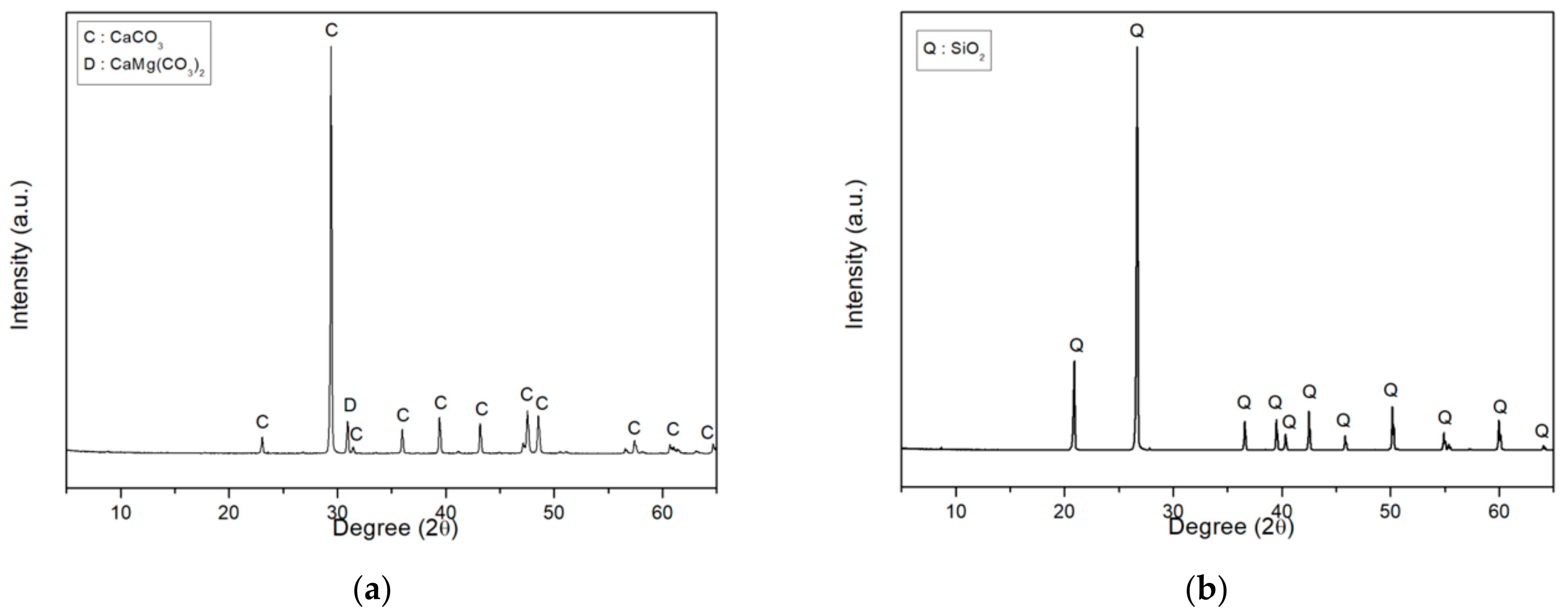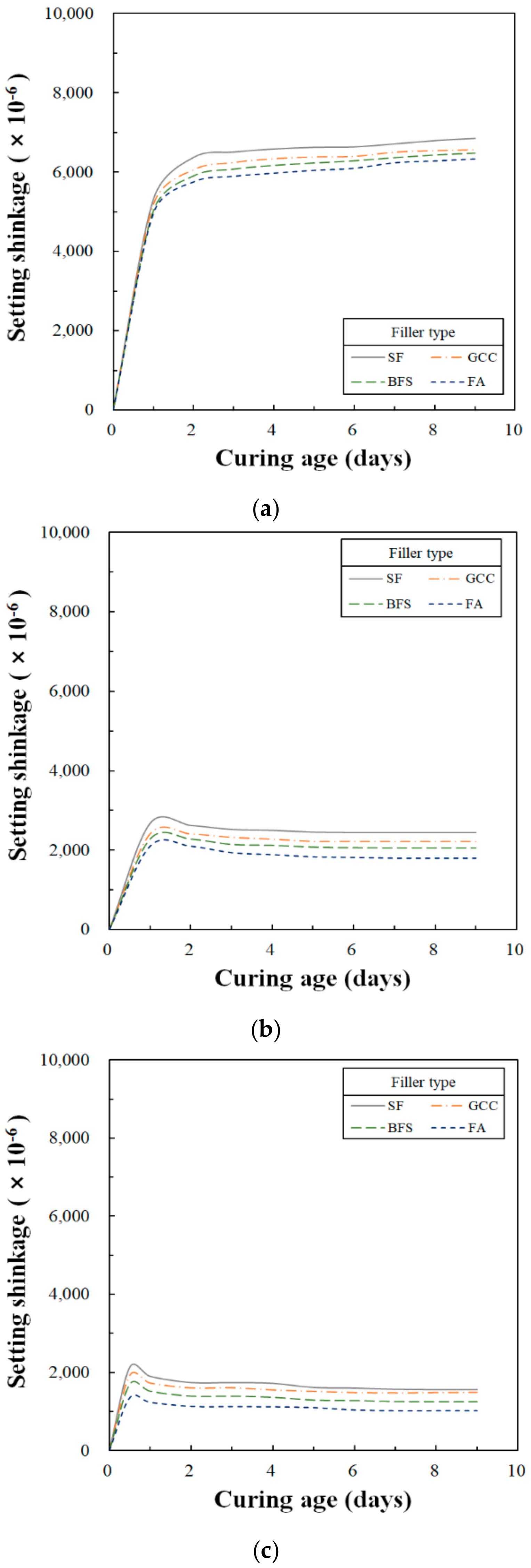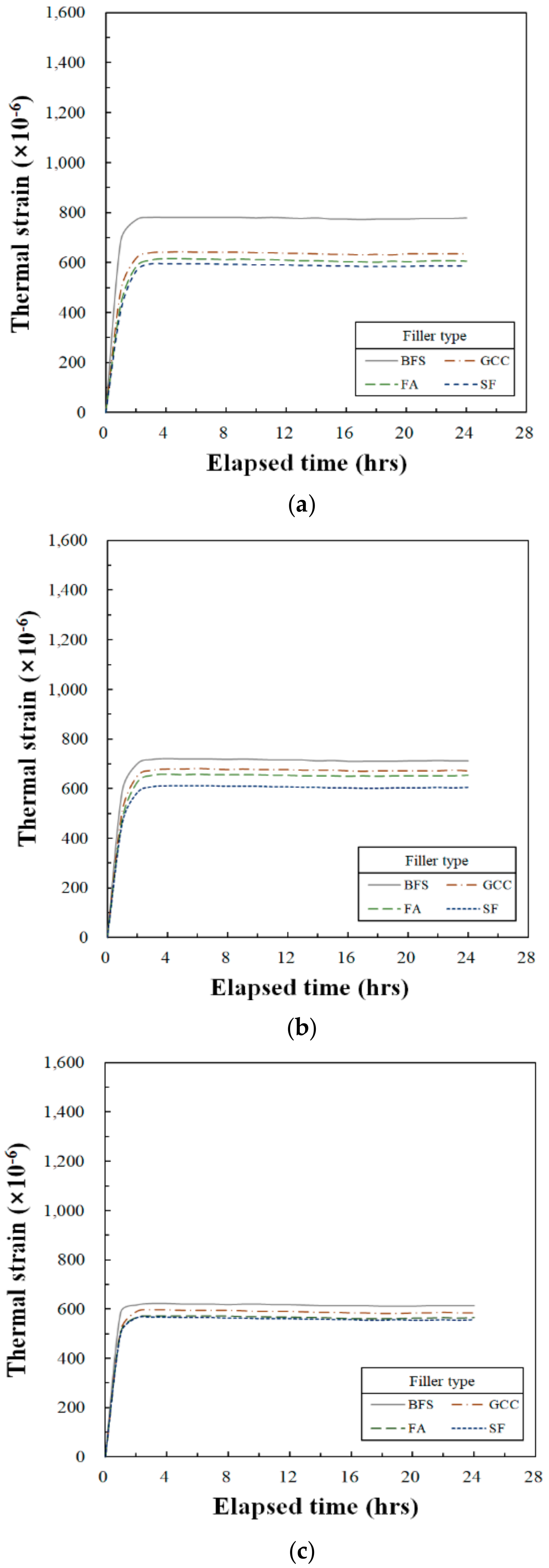Deformability in Unsaturated Polyester Resin-Based Concrete: Effects of the Concentration of Shrinkage-Reducing Agent and Type of Filler
Abstract
:1. Introduction
2. Significance of the Research
3. Experiment
3.1. Materials
3.1.1. Resin and Initiator
3.1.2. Shrinkage-Reducing Agent
3.1.3. Filler
3.1.4. Aggregate
3.2. Preparation of Specimen
3.2.1. Mix Design
3.2.2. Specimen Preparation
3.3. Test Methods
3.3.1. Setting Shrinkage Test
3.3.2. Linear Thermal Expansion Test
3.3.3. Stress-Strain Test
4. Results and Discussion
4.1. Setting Shrinkage and Thermal Expansion
4.1.1. Setting Shrinkage
4.1.2. Thermal Expansion
4.2. Stress-Strain Relationship
4.2.1. Maximum Compressive Strain
4.2.2. Modulus of Elasticity
5. Conclusions
- 1)
- The setting shrinkage was generally stabilized from 12 to 24 h after casting was completed. As the SRA content was increased, the setting shrinkage tended to decrease significantly, and there was no significant difference in setting shrinkage based on filler type.
- 2)
- Thermal expansion tended to decrease as the amount of SRA was increased, and the difference in thermal expansion was relatively substantial. Changes in filler produced significant differences depending upon the type used.
- 3)
- The maximum compressive strain also tended to decrease as the SRA content was increased, but the difference in compressive strain by the amount of SRA was not significant. There was no significant difference in the compressive strain based on changes in the filler type. As a result, it was determined that the effects of SRA content on setting and thermal shrinkage were not significant.
- 4)
- The modulus of elasticity decreased as the SRA content increased. In addition, there were significant differences in the decrease of the moduli of elasticity as the SRA content increased. However, there was no significant difference in the modulus of elasticity by filler types. Also, in this case, the effect of SRA contents on the elastic modulus was greater than the effect of filler types on that.
- 5)
- Setting shrinkage was affected by resin, SRA and filler. Additionally, the thermal expansion, maximum compressive strain and modulus of elasticity were affected not only by the resin, SRA, and filler, but also the aggregate. In this study, the effects of SRA content and filler type on setting shrinkage were investigated. As a result, the effect of SRA content on the deformability of UP polymer concrete was found to be more substantial than the effect of filler type.
- 6)
- It is desirable to determine the mix proportions, considering both the SRA content and the deformation properties by filler type as determined in this study, in order to secure the proper deformability of UP polymer concrete when it is applied to repair endeavors, structural or nonstructural precast products, etc.
- 7)
- The effects of filler type on deformability indicate that: setting shrinkage is influenced by evenly dispersed filler particles; the thermal expansion characteristics of fillers affect thermal expansion; small spherical particles tend to fill porosity, leading to better packing of the aggregate materials and influencing compressive strain; and the modulus of elasticity is influenced by density, which is related to the strength of the filler. Additional research is required to gather greater detail on these topics.
Author Contributions
Funding
Conflicts of Interest
References
- Chandra, S.; Ohama, Y. Polymers in Concrete, 1st ed.; CRC Press: Boca Raton, FL, USA, 1994. [Google Scholar]
- ACI Committee 548. Guide for the Use of Polymers in Concrete (ACI 548, 1R-86); American Concrete Institute: Detroit, MI, USA, 1986. [Google Scholar]
- Dikeou, J.T. Precast Polymer Concrete in the United States. 1987. Available online: http://romtecutilities.com/precast-polymer-concrete (accessed on 3 February 2020).
- Ferreira, A.J.Μ.C.; Tavares, C.; Ribeiro, C. Flexural Properties of Polyester Resin Concretes. J. Polym. Eng. 2000, 20, 459–468. [Google Scholar] [CrossRef]
- Rebeiz, K.S.; Craft, A.P. Polymer Concrete Using Coal Fly Ash. J. Energ. Eng. 2002, 128, 62–73. [Google Scholar] [CrossRef]
- Lokuge, W.; Aravinthan, T. Effect of Fly Ash on the Behaviour of Polymer Concrete with Different Types of Resin. Mater. Des. 2013, 51, 175–181. [Google Scholar] [CrossRef]
- Haddad, H.; Kobaisi, M.A. Optimization of the Polymer Concrete Used for Manufacturing Bases for Precision Tool Machines. Compos. Part. B Eng. 2012, 43, 3061–3068. [Google Scholar] [CrossRef]
- Kim, K.; Milstein, F. Relation between Hardness and Compressive Strength of Polymer Concrete. Constr. Build. Mater. 1987, 1, 209–214. [Google Scholar] [CrossRef]
- Rogers, M.E.; Long, T.E. Synthetic Methods in Step-Growth Polymers, 1st ed.; Wiley Online Library: Hoboken, NJ, USA, 2003. [Google Scholar]
- Xu, L.; Lee, L.J. Kinetic Analysis and Mechanical Properties of Nanoclay Reinforced Unsaturated Polyester (UP) Resins Cured at Low Temperatures. Polym. Eng. Sci. 2005, 45, 496–509. [Google Scholar] [CrossRef]
- Ribeiro, M.; Sousa, S.; Nóvoa, P. An Investigation on Fire and Flexural Mechanical Behaviors of Nano and Micro Polyester Composites Filled with SiO2 and Al2O3 Particles. Mater. Today Proc. 2015, 2, 8–19. [Google Scholar] [CrossRef]
- Fink, J.K. Reactive Polymers Fundamentals and Applications: A Concise Guide to Industrial Polymers, 2nd ed.; William Andrew: Norwich, NY, USA, 2013. [Google Scholar]
- Mani, P.; Gupta, A.K.; Krishnamoorthy, S. Comparative Study of Epoxy and Polyester Resin-Based Polymer Concretes. Int. J. Adhes. Adhes. 1987, 7, 157–163. [Google Scholar] [CrossRef]
- O’Connor, D.N.; Saiidi, M. Compatibility of Polyester-styrene Polymer Concrete Overlays with Portland Cement Concrete Bridge Decks. ACI Mater. J. 1993, 90, 59–68. [Google Scholar]
- Ribeiro, M.C.S.; Tavares, C.M.L.; Ferreira, A.J.M. Chemical Resistance of Epoxy and Polyester Concrete to Acids and Salts. J. Polym. Eng. 2002, 22, 27–44. [Google Scholar] [CrossRef]
- Gorninski, J.P.; Dal Molin, D.C.; Kazmierczak, C.S. Strength Degradation of Polymer Concrete in Acidic Environments. Cem. Concr. Compos. 2007, 29, 637–645. [Google Scholar] [CrossRef]
- Hashemi, M.J.; Jamshidi, M.; Hassanpour Aghdam, J. Investigating Fracture Mechanics and Flexural Properties of Unsaturated Polyester Polymer Concrete (UP-PC). Constr. Build. Mater. 2018, 163, 767–775. [Google Scholar] [CrossRef]
- Lim, S.K.; Hussin, M.W.; Zakaria, F.; Ling, T.C. GGBFS as Potential Filler in Polyester Grout: Flexural Strength and Toughness. Constr. Build. Mater. 2009, 23, 2007–2015. [Google Scholar] [CrossRef]
- Moodi, F.; Kashi, A.; Ramezanianpour, A.A.; Pourebrahimi, M. Investigation on Mechanical and Durability Properties of Polymer and Latex-Modified Concretes. Constr. Build. Mater. 2018, 191, 145–154. [Google Scholar] [CrossRef]
- Osburg, A.; Gypser, A.; Ulrich, M. Development of Polymer Concrete with Non-Standardised Fillers for Innovative Building Materials. Advan. Mater. Res. 2015, 1129, 484–491. [Google Scholar] [CrossRef]
- ASTM D 7481-18. Standard Test Methods for Determining Loose and Tapped Bulk Densities of Powders using a Graduated Cylinder. Available online: https://www.astm.org/Standards/D7481.htm (accessed on 30 January 2020).
- ASTM C596-18. Standard Test Method for Drying Shrinkage of Mortar Containing Hydraulic Cement. Available online: http://www.astm.org/cgi-bin/resolver.cgi?C596-18 (accessed on 19 December 2019).
- ASTM C531–18. Standard Test Method for Linear Shrinkage and Coefficient of Thermal Expansion of Chemical-Resistant Mortars, Grouts, Monolithic Surfacings, and Polymer Concretes. Available online: http://www.astm.org/cgi-bin/resolver.cgi?C531-18 (accessed on 19 December 2019).
- ASTM C 469M–14. Standard Test Method for Static Modulus of Elasticity and Poisson’s Ratio of Concrete in Compression. Available online: http://www.astm.org/cgi-bin/resolver.cgi?C469C469M-14 (accessed on 19 December 2019).
- Yeon, K.S.; Joo, M.K.; Jin, N.J.; Kwon, Y.H. Workability and Setting Shrinkage of Methyl Methacrylate (MMA)-Modified Polyester Polymer Concretes; El-Dieb, A.S., Taha, M.R., Lissel, S.L., Eds.; RILEM Publications SARL: Paris, France, 2003. [Google Scholar]
- Rebeiz, K.S.; Serhal, S.P.; Craft, A.P. Properties of Polymer Concrete Using Fly Ash. J. Mater. Civ. Eng. 2004, 16, 15–19. [Google Scholar] [CrossRef]
- Mani, P.; Krishnamoorthy, S.; Gupta, A.K. Role of Styrene-Based Shrinkage Reducing Agent in Polyester Resin Concrete. Inter. J. Adhes. Adhes. 1983, 3, 101–105. [Google Scholar] [CrossRef]
- Neville, A.M. Properties of Concrete, 4th ed.; John Wiley & Sons: Hoboken, NJ, USA, 1996. [Google Scholar]
- Mehta, P.K.; Monteiro, P.J.M. Concrete: Microstructure, Properties, and Materials, 3rd ed.; McGraw Hill: New York, NY, USA, 2006. [Google Scholar]
- Kim, K.K.; Yeon, J.; Lee, H.J.; Yeon, J.H. Dimensional Stability of SBR-Modified Cementitious Mixtures for Use in 3D Additive Construction. Appl. Sci. 2019, 9, 3386. [Google Scholar] [CrossRef] [Green Version]
- Valore, R.C.; Naus, D.J. Resin Bound Aggregate Material Systems. Available online: https://www.resinsrus.co.uk/ (accessed on 3 February 2020).
- The Engineering ToolBox. Available online: https://www.engineeringtoolbox.com/linear-expansion-coefficients-d_95.html (accessed on 19 December 2019).
- Mastalygina, E.E.; Ovchinnikov, V.A.; Chukhlanov, V.Y. Light Heat-Resistant Polymer Concrete based on Oligooxyhydridesilmethylensiloxysilane and Hollow Spherical Fillers. Mag. Civ. Eng. 2019, 90, 37–46. [Google Scholar]
- Mailvaganam, N.P. Repair and Rehabilitation of Concrete Structures: Current Practice and Emerging Technologies, In Evaluation, Repair and Retrofit of Structures Using Advanced Methods and Materials. In Proceedings of the First International Civil Engineering “Egypt-China-Canada” Symposium, Cairo, Egypt, 18–20 December 1997. [Google Scholar]
- Bedi, R.; Chandra, R.; Singh, S.P. Mechanical Properties of Polymer Concrete. J. Compos. 2013, 948745. [Google Scholar] [CrossRef] [Green Version]
- ACI Committee 548. Guide for Polymer Concrete Overlays; American Concrete Institute: Farmington Hills, MI, USA, 2016. [Google Scholar]
- Ostad-Ali-Askari, K.; Singh, V.P.; Dalezios, N.R.; Crusberg, T.C. Polymer Concrete. Int. J. Hydrogen Energy 2018, 2, 630–635. [Google Scholar]







| Specific Gravity (25 °C) | Viscosity (25 °C, mPa·s) | Acid Value | Styrene Content (%) |
|---|---|---|---|
| 1.12 | 300 | 18.4 | 40 |
| Component | Specific Gravity (25 °C) | Active Oxygen Content (%) | Refractive Index |
|---|---|---|---|
| MEKPO 55% DMP 45% | 1.17 | 9.88 | 1.4828 |
| Component | Specific Gravity (25 °C) | Viscosity (25 °C, mPa∙s) | Appearance |
|---|---|---|---|
| Polystyrene 40.6% Styrene monomer 50.4% | 1.2 | 8900 | Transparent |
| Filler | Density (g/cm3) | Particle Size (μm) | Chemical Composition (%) | |||||||
|---|---|---|---|---|---|---|---|---|---|---|
| Mean | Median | Mode | SiO2 | Al2O3 | CaO | MgO | Fe2O3 | SO3 | ||
| Ground calcium carbonate (GCC) | 2.70 | 18.18 | 14.57 | 28.70 | 0.62 | 0.48 | 53.8 | 1.21 | 0.15 | 0.01 |
| Silica flour (SF) | 2.65 | 31.77 | 22.74 | 37.97 | 98.7 | 0.52 | 0.08 | 0.03 | 0.18 | 0.02 |
| Filler | Density (g/cm3) | Particle Size (μm) | Chemical Composition (%) | |||||||
|---|---|---|---|---|---|---|---|---|---|---|
| Mean | Median | Mode | SiO2 | Al2O3 | CaO | MgO | Fe2O3 | SO3 | ||
| Fly ash (FA) | 2.20 | 22.29 | 10.75 | 7.77 | 49.1 | 22.7 | 7.15 | 1.33 | 8.31 | 0.99 |
| Blast furnace slag (BFS) | 2.91 | 13.41 | 10.10 | 16.40 | 29.3 | 13.3 | 48.5 | 2.72 | 0.53 | 2.94 |
| Size (mm) | Density (g/cm3) | Unit Weight (kg/m3) | Fineness Modulus | Water Content (%) | Chemical Composition (%) | |||
|---|---|---|---|---|---|---|---|---|
| SiO2 | Al2O3 | TiO2 | Fe2O3 | |||||
| 0.2–8.0 | 2.65 | 1652 | 2.81 | < 0.1 | 97.3 | 1.59 | 0.02 | 0.50 |
| UP resin | SRA | Filler | Aggregate | Initiator (phr) |
|---|---|---|---|---|
| 13.00 (100) | 0 (0) | 19 | 68 | (1) |
| 11.70 (90) | 1.30 (10) | 19 | 68 | (1) |
| 11.05 (85) | 1.95 (15) | 19 | 68 | (1) |
| Filler Types | Setting Shrinkage (×10−6) | ||
|---|---|---|---|
| SRA 0% | SRA 10% | SRA 15% | |
| FA | 6333 | 1799 | 1020 |
| BFS | 6480 | 2056 | 1248 |
| GCC | 6562 | 2220 | 1489 |
| SF | 6849 | 2445 | 1560 |
| Filler Types | Thermal Strain (×10−6 °C−1) | ||
|---|---|---|---|
| SRA 0% | SRA 10% | SRA 15% | |
| SF | 11.5 | 13.1 | 14.2 |
| FA | 12.3 | 13.5 | 14.3 |
| GCC | 13.8 | 14.5 | 14.5 |
| BFS | 19.5 | 16.8 | 16.6 |
| Filler Types | Max. Compressive Strain (×10−6) | ||
|---|---|---|---|
| SRA 0% | SRA 10% | SRA 15% | |
| FA | 4940 | 3765 | 3595 |
| BFS | 5100 | 3957 | 3753 |
| GCC | 5403 | 4400 | 3880 |
| SF | 5558 | 4798 | 4004 |
| Filler Types | Compressive Strength (MPa) | ||
|---|---|---|---|
| SRA 0% | SRA 10% | SRA 15% | |
| FA | 92.7 | 83.2 | 78.3 |
| BFS | 96.7 | 88.2 | 82.6 |
| GCC | 102.8 | 95.2 | 86.7 |
| SF | 105.2 | 101.0 | 90.5 |
| Filler Types | Elastic Modulus (×103 MPa) | ||
|---|---|---|---|
| SRA 0% | SRA 10% | SRA 15% | |
| FA | 27.3 | 25.8 | 22.0 |
| BFS | 27.4 | 26.4 | 24.8 |
| GCC | 28.5 | 27.9 | 26.6 |
| SF | 30.6 | 29.5 | 28.9 |
© 2020 by the authors. Licensee MDPI, Basel, Switzerland. This article is an open access article distributed under the terms and conditions of the Creative Commons Attribution (CC BY) license (http://creativecommons.org/licenses/by/4.0/).
Share and Cite
Yeon, J.H.; Lee, H.J.; Yeon, J. Deformability in Unsaturated Polyester Resin-Based Concrete: Effects of the Concentration of Shrinkage-Reducing Agent and Type of Filler. Materials 2020, 13, 727. https://doi.org/10.3390/ma13030727
Yeon JH, Lee HJ, Yeon J. Deformability in Unsaturated Polyester Resin-Based Concrete: Effects of the Concentration of Shrinkage-Reducing Agent and Type of Filler. Materials. 2020; 13(3):727. https://doi.org/10.3390/ma13030727
Chicago/Turabian StyleYeon, Jung Heum, Hee Jun Lee, and Jaeheum Yeon. 2020. "Deformability in Unsaturated Polyester Resin-Based Concrete: Effects of the Concentration of Shrinkage-Reducing Agent and Type of Filler" Materials 13, no. 3: 727. https://doi.org/10.3390/ma13030727





